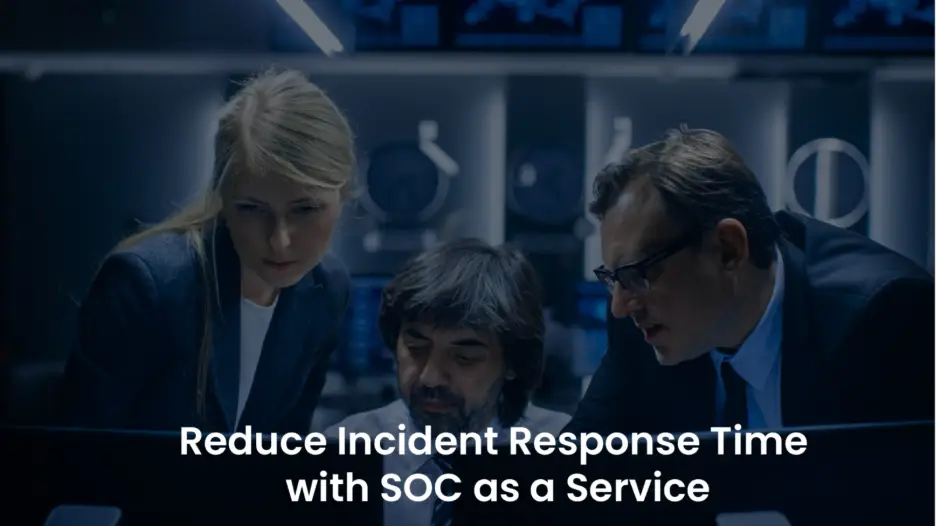
Before diving into the intricacies of SOC as a Service (SOCaaS), it’s essential to first grasp the concept of a Security Operations Center (SOC), which encompasses its fundamental functions, capabilities, and the critical role it plays in protecting an organization’s digital infrastructure. Understanding this context underscores the importance of SOCaaS.
This article explores how SOC as a Service significantly reduces incident response time by examining its importance, best practices, and essential metrics such as MTTD (Mean Time to Detect) and MTTR (Mean Time to Respond). It elaborates on how SOCs maintain constant monitoring, implement automated triage systems, and coordinate responses across cloud and endpoint environments. Furthermore, it explains how integrating SOCaaS with existing security frameworks increases visibility and fortifies cybersecurity resilience. Readers will learn how a robust SOC strategy, practical drills, and comprehensive threat intelligence contribute to expedited containment, along with the benefits of utilizing managed SOC services to access elite analysts, cutting-edge tools, and scalable processes without the burden of developing these capabilities internally.
Effective Strategies for Reducing Incident Response Time with SOC as a Service
To effectively decrease incident response time through SOC as a Service (SOCaaS), organizations need to align technology, processes, and expertise to rapidly identify and contain potential threats before they escalate into serious issues. A dependable managed SOC provider incorporates continuous monitoring, advanced automation, and a skilled security team to enhance every step of the incident response lifecycle, ensuring a proactive rather than reactive approach to cybersecurity.
A Security Operations Center (SOC) acts as the central command hub for an organization’s cybersecurity framework. When delivered as a managed service, SOCaaS integrates vital components such as threat detection, threat intelligence, and incident management into a cohesive system that enables organizations to address security incidents in real-time. This comprehensive approach allows for timely interventions that can mitigate damages before they escalate.
Effective strategies to minimize response time include:
- Continuous Monitoring and Detection: By utilizing cutting-edge security tools and SIEM (Security Information and Event Management) platforms, organizations can analyze logs and correlate security events seamlessly across various endpoints, networks, and cloud services. This real-time monitoring provides a comprehensive view of emerging threats, drastically reducing detection times while helping to prevent potential breaches from occurring.
- Automation and Machine Learning: SOCaaS platforms leverage the capabilities of machine learning to automate routine triage tasks, prioritize urgent alerts, and initiate predefined containment strategies. This level of automation cuts down on the time security analysts spend on manual investigations, thereby enabling faster and more efficient responses to incidents that could otherwise lead to significant damage.
- Skilled SOC Team with Clearly Defined Roles: A dedicated response team consists of seasoned SOC analysts, cybersecurity experts, and incident response specialists who operate with clearly defined roles and responsibilities. This structured approach guarantees that every alert receives immediate and appropriate attention, thereby enhancing overall incident management and ensuring swift action is taken when threats are detected.
- Integrated Threat Intelligence and Proactive Threat Hunting: Proactive threat hunting, supported by global threat intelligence, facilitates the early detection of suspicious activities, thus minimizing the risk of successful exploitation and significantly enhancing incident response capabilities across the organization.
- Unified Security Stack for Improved Coordination: SOCaaS consolidates various security operations, threat detection, and information security functions under one provider. This integration fosters improved coordination among security operations centers, leading to quicker response times and reduced resolution times for incidents, ultimately enhancing overall security effectiveness.
Why is SOC as a Service Critical for Minimizing Incident Response Time?
Here’s why SOCaaS is indispensable:
- Continuous Visibility Across Security Environments: SOC as a Service provides real-time visibility across endpoints, networks, and cloud infrastructures, allowing for the early identification of vulnerabilities and unusual behaviors before they culminate in significant security breaches. This persistent monitoring is vital for maintaining a strong security posture.
- 24/7 Monitoring and Rapid Incident Response: Managed SOC operations run around the clock, meticulously analyzing security alerts and events. This constant vigilance ensures swift incident responses and quick containment of cyber threats, ultimately enhancing the overall security posture of the organization.
- Access to Expert Security Teams for Timely Actions: Partnering with a managed service provider grants organizations access to highly trained security experts and incident response teams. These professionals can effectively assess, prioritize, and respond to incidents promptly, removing the financial burden of maintaining an in-house SOC while ensuring expert-level incident management.
- Automation and Cohesive Security Solutions: SOCaaS incorporates advanced security solutions, analytics, and automated response playbooks to streamline incident response strategies. This integration significantly reduces delays caused by human intervention in threat analysis and remediation efforts, allowing for a more efficient security response.
- Enhanced Threat Intelligence Capabilities for Proactive Defense: Managed SOC providers utilize global threat intelligence to proactively identify emerging risks within the evolving threat landscape, thereby strengthening an organization’s defenses against potential cyber threats that could compromise sensitive information.
- Improved Overall Security Posture Through Automation: By integrating automation with expert analysts and scalable infrastructure, SOCaaS empowers organizations to maintain a resilient security posture, effectively addressing contemporary security demands without straining internal resources, thus promoting long-term sustainability.
- Strategic Alignment for Enhanced Focus on Security Initiatives: SOC as a Service enables organizations to concentrate on strategic security initiatives while the third-party provider manages day-to-day monitoring, detection, and threat response activities. This effectively reduces the mean time to detect and resolve incidents, optimizing resource allocation.
- Real-Time Management of Security Incidents for Efficient Recovery: Integrated SOC monitoring and analytics provide a comprehensive view of security events, enabling managed security services to identify, respond to, and recover from potential security incidents with impressive efficiency, thereby minimizing the impact on business operations.
What Proven Best Practices Enhance Incident Response Time with SOCaaS?
Here are the most effective best practices to consider:
- Develop a Comprehensive SOC Strategy: Clearly define structured processes for detection, escalation, and remediation. A well-articulated SOC strategy ensures that each phase of the incident response process is executed effectively across various teams, ultimately enhancing overall operational efficiency.
- Implement Continuous Security Monitoring for Proactive Threat Management: Ensure 24/7 security monitoring across all networks, endpoints, and cloud environments. This proactive approach facilitates early detection of anomalies, significantly diminishing the time needed to identify and contain potential threats before they escalate into serious issues.
- Automate Incident Response Workflows to Enhance Efficiency: Integrate automation within SOC solutions to expedite triage, analysis, and remediation processes. Automation not only minimizes the need for manual intervention but also enhances the overall quality of response operations, ensuring a faster and more reliable incident management process.
- Leverage Managed Cybersecurity Services for Seamless Scalability: Partnering with specialized cybersecurity service providers allows organizations to seamlessly scale their services while ensuring expert-led threat detection and mitigation, all without the operational challenges associated with maintaining an in-house SOC.
- Conduct Regular Threat Simulations for Enhanced Preparedness: Carry out simulated attacks, such as DDoS (Distributed Denial of Service) drills, to evaluate an organization’s security readiness. These simulations identify operational gaps and refine the incident response process, ultimately enhancing the organization’s overall resilience against genuine threats.
- Enhance Data Security and Visibility Across All Systems: SOCaaS platforms consolidate telemetry from multiple systems, offering unified visibility into network, application, and data security layers. This comprehensive perspective significantly shortens the time between detection and containment of threats, thereby improving the overall effectiveness of incident response efforts.
- Integrate SOC with Existing Security Tools for Cohesion: Align current security tools and platforms within the managed SOC ecosystem to break down silos and improve overall security outcomes. This collaboration fosters a more integrated and effective security environment, which is crucial for timely incident response.
- Adopt Solutions Compliant with Industry Standards for Enhanced Efficiency: Collaborate with reputable vendors, such as Palo Alto Networks, to integrate standardized security solutions and frameworks that promote interoperability while reducing the frequency of false positives in threat detection.
- Continuously Measure and Optimize Incident Response Performance: Regularly monitor key metrics, including mean time to detect (MTTD) and mean time to respond (MTTR), to uncover opportunities for reducing delays in response cycles and enhancing the maturity and effectiveness of SOC operations.
The Article Reduce Incident Response Time with SOC as a Service Was Found On https://limitsofstrategy.com
